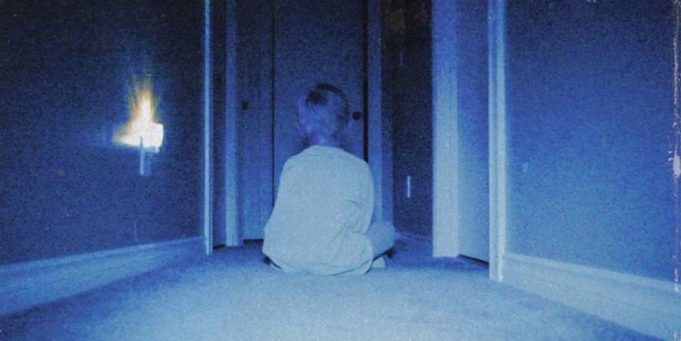The controversial movie of this January has been Skinamarink, and wherever film controversy is, that’s where I’m headed. Most horror movies become controversial because of blood and gore or copious nudity, but this is quite the opposite. The obliqueness of this Canadian import has people debating whether this is a brilliant exercise in deconstruction of cinematic tropes or elevated horror that’s just too damn elevated. I’m afraid I’m in the latter camp, though if this does look like a student film, it’s the work of a talented student.
The plot set in 1995 concerns a 6-year-old boy named Kevin (Lucas Paul) and his 4-year-old sister Kaylee (Dali Rose Tetreault), though you seldom see their faces. At times, the dialogue is so faint that the film provides us with subtitles so that we can understand, though I did need the press materials to catch on that the kids’ parents mysteriously vanish, as do the house’s doors and windows. The movie is full of poorly lit shots of their house, some of which are only lit by a child’s night light or a switched-on TV — what Thomas Pynchon once called “Tubeglow.”
I take the point of first-time feature filmmaker Kyle Edward Ball here, which is that anybody’s house looks ominous at night after everybody has gone to bed. (He filmed this in his own childhood home in Edmonton, by the way.) When a camera is sitting in an empty, darkened living room, we assume that something’s going to happen to merit the camera’s presence, and when it moves, we assume that our eye is going to be directed toward some important detail. The Paranormal Activity movies did this a lot, with the crucial difference that they tried and occasionally succeeded in paying that off.
If you’ve read much about how horror cinema works, you’ve probably heard about the power of indirection. The monster that’s lurking just out of the frame is usually scarier than the one we’re looking squarely at. Still, when indirection is all a movie has, that can lead spectators to feel cheated, especially when they’ve paid good money for their tickets. Early on, there’s a shot of an empty corridor, over which we hear Kaylee ask, “Why are you hiding?”, and we can see neither her nor the person she’s speaking to. And yes, that’s undeniably eerie. After that, though, what we get are mostly shots of ceilings and floors backed by the sound of public-domain cartoons that the kids watch on TV. A closet door is opened by something we can’t see, though we only see the top of the door, so it could very well be opened by someone who’s inside or outside the closet and crouching low. Ball is looking to strip horror down to its bare bones, and he does it so zealously that he manages to take off a good portion of the bones as well.
There is one effective scare very late in the film involving a toy telephone. Ball does have a good sense of composition and sound. I suspect that if he had hung still photos from this movie in a gallery, we’d be calling him the next Cindy Sherman. Even so, for all his skill at deploying faraway noises and half-glimpsed shapes in the shadows, Skinamarink plays like a comedy set by a stand-up who deliberately refuses to deliver the punchline. It’s unsatisfying as a horror movie, but as an exercise in perversity, it’s good enough to inspire me to write enough words for this article.
Skinamarink
Starring Lucas Paul and Dali Rose Tetreault. Written and directed by Kyle Edward Ball. Not rated.












